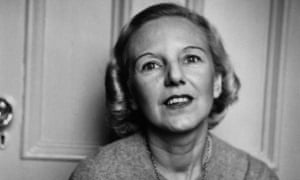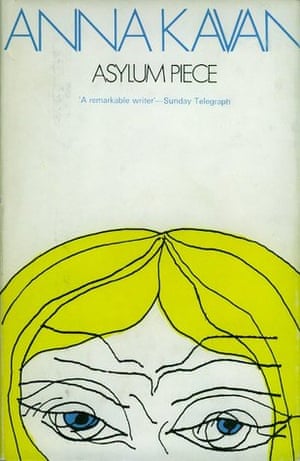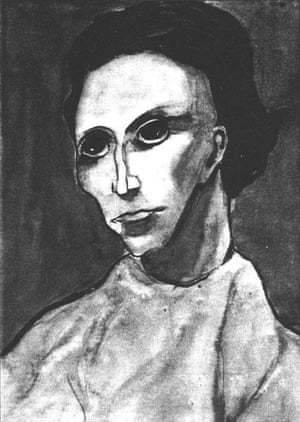 |
| ‘She wrote in a mirror’ … Anna Kavan |
'Enough heroin to kill the whole street': does Anna Kavan's life overshadow her fiction?
The details of Anna Kavan’s life loom large over her work, says Chris Power, but the brilliant light of her short fiction illuminates psychological trauma and mortality
Chris Power
Thu 13 February 2020
Anna Kavan’s 1943 essay about her time living in New Zealand begins with unusual reluctance: “I have not got any useful information about New Zealand,” she writes, and “would not attempt to give it to you if I had. The transmission of information is not my department. The only job for which I am qualified as an individualist and a subjective writer is the recording of my personal reactions.”
It is an irony that not merely in Kavan’s essays but also her fiction, “the transmission of information” – chiefly about her personal life – has taken on significant weight. If she is known for anything beyond her 1967 novel Ice, it is for having suffered mental illness, having been disastrously married (twice), and having been addicted to heroin, all of which she explored in her writing. You would have to search very hard to find an article about her that doesn’t mention the police statement, following the discovery of her corpse in December 1968, a fully loaded syringe in one arm, that her Notting Hill flat contained “enough heroin to kill the whole street”.
Details like these mean Kavan’s biography can get in the way of her fiction, something the author may have encouraged by adopting one of her own character’s names after publishing her first six novels as Helen Ferguson. As Zadie Smith wrote in her 2008 essay, Two Paths for the Novel, “for the British avant garde, autobiographical extremity has become a mark of literary authenticity, the drug use of Alexander Trocchi and Anna Kavan being at least as important to their readers as their prose”. This is certainly true of her biographers. Kavan led a peripatetic, sometimes chaotic and largely unrecorded life, destroying much of her correspondence and all but one year of her journal (1926–27). As a result, both of the biographies written about her dwell on her drug use, and have a questionable tendency to use her fiction as documentary evidence, going so far as to ascribe lines spoken or thought by a narrator to their author. As Victoria Walker notes in the introduction to a recent collection of Kavan’s stories and journalism, “her characters’ fictional experiences have been appropriated to enhance the known facts of her life”.
“She wrote in a mirror,” claimed Kavan’s friend Rhys Davies in a 1970 essay of remembrance, but everyone does to some degree. There is a gendered aspect to the discussion of Kavan’s work. Male writers are allowed to imagine, female writers only to confess; Flaubert can say, “Madame Bovary, c’est moi” without being accused of narcissism. In any case, the question isn’t whether a writer holds a mirror up to their life, but whether what’s reflected is something others find interesting. To settle that, one needn’t go further than Asylum Piece (1940), the first book Kavan wrote under that name. It was her first story collection, and also her first masterpiece, though the outbreak of the second world war meant that, despite excellent reviews, it quickly sank from sight.
The book consists of two story cycles and some odds and ends. The eight-part Asylum Piece suite draws on her experiences in a Swiss sanatorium, but doesn’t feel confessional. One of the best, Asylum Piece: 7, describes a French barrister escaping a sanatorium in a rowing boat. When he begins crossing Lake Geneva he is convinced he is “quite well – it’s not as if there ever was much wrong with me”, and briefly entertains the thought that his wife has had him committed for underhand reasons. But his uncertainty grows as he crosses the lake, and unpleasant thoughts crowd his mind: “the gendarmes, the questions, the significant looks” that will confront him if he steps ashore. Finally, a few yards from freedom, looking “worn and dejected”, and “much older” than the man who set out, he turns the boat around and heads back to the asylum. In charting one man’s awful self-realisation about his mental state, and its description of a journey that is simultaneously physical and psychological, the story is a cousin to John Cheever’s The Swimmer.
The most impressive element of the Asylum Piece stories is how they convey psychological trauma through absolutely controlled prose. Anaïs Nin, a huge admirer of Kavan who tried on numerous occasions to meet her (the admiration wasn’t mutual, and she never did), considered Asylum Piece, “an example of classical lucidity while entering irrational worlds”. There is an impressive minimalism at work through much of the collection, an ability to create a destabilising atmosphere without destabilising the text. In a 1944 book review Kavan wrote that “[t]he short story is like a small room in which is concentrated a brilliant light”, and in Asylum Piece that light burns with pitiless clarity.
The collection’s other story cycle displays the extent of Kavan’s debt to Kafka (Brian Aldiss called her “Kafka’s sister”, although daughter might be more accurate). We can call them her “adviser stories”, a sequence that continued into her next collection, I Am Lazarus (1945), and in the atmosphere of stories she wrote for the subsequent two decades. In them, a woman consults a variety of “advisers” about the charges brought against her, or the judgement she awaits. Playing out in the shadow of Kafka’s novel The Trial (one of Kavan’s stories is called The Summons), the charges against the narrator are never specified, the workings of the process are occluded, and the time when the sentence will be handed down is unknown.
In The Art of the Novel, Milan Kundera describes Kafka’s quintessential character as a functionary. “In the bureaucratic world of the functionary,” he writes, “there is no initiative, no invention, no freedom of action”, and the subjects of Kavan’s adviser stories also lack these qualities. But she goes a step beyond Kafka, whose character K had a job that his persecution interfered with. Kavan’s characters are much more isolated, to the extent of being utterly removed from the world:
“The sun was shining, and I was astonished to see that during the period I had remained indoors, too preoccupied with my troubles even to look out of the window, the season seemed to have passed from winter to spring.”
The adviser stories are awash with such queasy uncertainty, where one season might lapse into another unnoticed, where every postman’s visit might bring the letter sealing one’s fate, and where we do not know if the stories describe one interminable case, or multiple identical ones. Even when the stories are definitely linked, as in Airing a Grievance and Just Another Failure, both of which feature an adviser called D, Kavan frays the connections between them: “I think I finally decided that D must remind me of some portrait seen long before in a gallery,” her narrator comments in the first story, but in the second she remarks that D’s face, “always vaguely reminded me of some other face I had seen long ago, I couldn’t remember quite where, perhaps in a painting or a newspaper photograph”. The slippage suggests the narrator’s mind is failing, and makes her vulnerability in the face of the mysterious court even more vivid.
Several of the adviser stories suggest a Jarndyce v Jarndyce complexity to the case being brought. In Our City, the narrator refers to “the enormously intricate labyrinth which a case that’s been going on as long as mine has is bound to become”. The inference to draw from this, and from Kafka’s work – is that the case against one, and one’s own existence, are identical.
Beyond the adviser stories, Kavan writes about situations in which her subjects, most often women, are put in situations fraught with uncertainty and threat, but in which they have greater agency. In Benjo, the narrator of the title is working on her house in rural New Zealand. Benjo, an inscrutable man who lives in a ruin of a caravan, spectates as she labours, “all the while smiling with the sort of complacent expression that might be worn by a landlord who watches a good tenant improving his property”. Benjo is a masterclass in building tension: realist in detail, but operating more like a ghost story in the way it calibrates mystery and anxiety.
A Bright Green Field, the title story of Kavan’s 1958 collection, really is a ghost story, although a field of grass must be one of the more unlikely phantoms in literature:
“In my travels I am always being confronted by a particular field. It seems that I simply can’t escape it. Any journey, no matter where it begins, is apt to end towards evening in sight of this meadow, which is quite small, sloping and in the vicinity of tall dark trees.”
For all the story’s evocation of an Alpine or Scandinavian otherness, by its end the green field appears to be best understood as an inescapable aspect of the narrator’s psyche: “If not today or tomorrow, then the day after that, or the next, at the end of some journey one evening, I shall see the bright green field waiting for me again. As I always do.”
During the war, Kavan worked at the Mill Hill Emergency Hospital (pdf), where much of the Maudsley was evacuated during the blitz. She interviewed soldiers with psychological problems and the experience, combined with her own episodes of hospitalisation, further enriched her writing about fragile mental states. I Am Lazarus describes a young Englishman in a French hospital. He has undergone narcosis therapy, and seems much improved, but his inner state is fraught. “At any moment,” Kavan writes, “something might pounce on him, something for which he did not have the formula. He waited tensely, on enemy ground.” In The Blackout, a powerful account of what appears to be PTSD, one line above all conveys the mental state of the young soldier: “The room was small and there was nothing at all alarming about it.” While most of us experience the world as a safe place that can sometimes become perilous, his relationship to it has become horrifyingly inverted. For him, it is not the presence of a threat but its absence that is remarkable.
In Glorious Boys, a woman in a night-time London “vibrant with the resonance of out-going bombers” teeters on the edge of a breakdown, prey to thoughts she describes as “the work of the saboteur in the nerves”. Kavan’s psyche was similarly fragile, something she sought to remedy by injecting heroin for most of her adult life. Despite this, and her reputation as a druggy writer, her books are largely free of drug references before her posthumously published collection, Julia and the Bazooka (1970). In its most notable sequence of stories Kavan attempts to process the grief she felt following the death, in 1964, of her doctor, Karl Bluth, who kept her legally supplied with heroin for almost 20 years.
The best of these is The Mercedes, a dreamlike story in which M, Bluth’s surrogate, is trying to get home from the narrator’s flat late one wet night. On the street outside, the pair find a car that has mysteriously appeared at the kerb. When M gets inside, it suddenly moves off. The narrator cannot open the door or keep up as the car glides away, “as smoothly and silently as water flowing downhill, and just as inevitably”. The rain has stopped, and the slick street looks like “a black river”. We can suppose that it is one: the Styx.
While death is a constant through Kavan’s writing, it comes increasingly to the fore in her later work. She attempted suicide numerous times, and many of her characters are on the verge of it. In one of the adviser stories, An Unpleasant Reminder, the narrator is given a suicide pill, “the judgment I had awaited so long”. When she takes it, however, it turns out to be a sugar pill, “just a reminder of what is in store for me”. In another story an unhappily married man considers his escape routes: “A bottle three-quarters full of barbiturates up in the bathroom. My shotgun. The car exhaust. Razor blades.”
But the most moving engagement with death in Kavan’s work is a suicide that doesn’t happen. In One of the Hot Spots, the narrator is aboard a ship anchored off Java, wondering what it would feel like to “drop down into the sea one dark night when everyone was asleep”. The purser tells her that he once saw a man jump off the ship, “feet first, with his leather shoes on”. But when the purser went to the railing, he saw the same man climbing the ship’s ladder. He came back on deck, checked his watch, and went back to his cabin. It is tempting to think of this suicide revoked as being somehow related to Kavan’s father, who either fell or, more likely, threw himself from the prow of a ship off the coast of Mexico when she was 10 years old.
In Our City, Kavan’s narrator considers her collection of books, “like members of a suicide squad who do not hesitate to engage the enormously superior enemy, life”. Do her books offer similar protection? Taken as a whole, her stories present us with a series of characters being challenged and, in most cases, overmatched by life. “Life is just a nightmare and the universe has no meaning,” she wrote to her friend Raymond Marriott in 1965, and her work, stark with “brilliant light”, offers no false consolation. This is one of its enduring strengths. In an extraordinary book review published in Horizon in 1946, she asserted that:
“Writers of the quality of Kafka and Gogol do not run away from reality. They have too much integrity, both as artists and human beings, to indulge in escapist flights. Especially sensitive, they are especially vulnerable, and they escape nothing … The artistic value of their work endures because it is also a part of reality. It is conscious, uncompromising, personal, true. It is life.”
It is life, and it does not shy from confronting death. Like Kafka’s K, we know what our sentence is going to be. Anna Kavan might have written in a mirror, but what she saw there is what we will all see, sooner or later.
Neurosis, paranoica y heroína / El descenso de Anna Kavan
Todas las vidas, las reencarnaciones y el descenso de Anna Kavan
DRAGON
'Enough heroin to kill the whole street' / Does Anna Kavan's life overshadow her fiction?





No comments:
Post a Comment